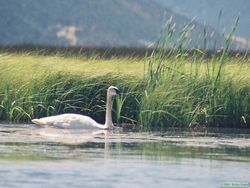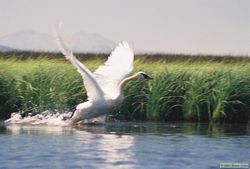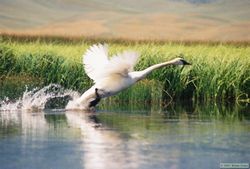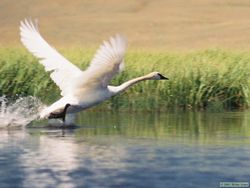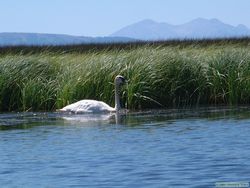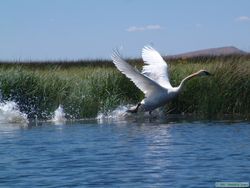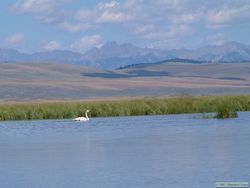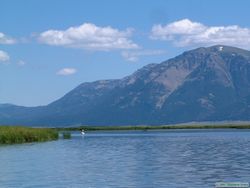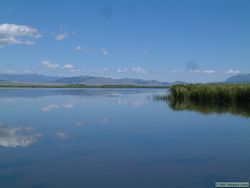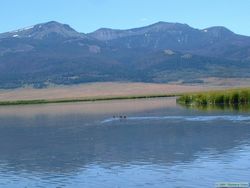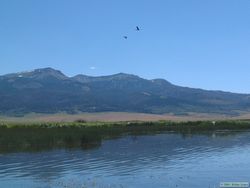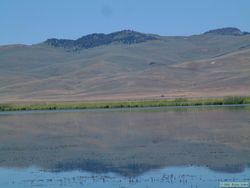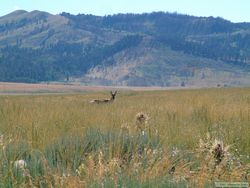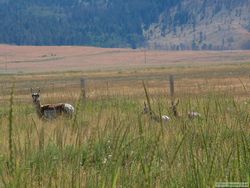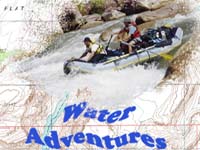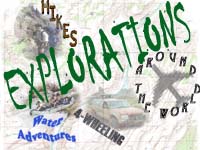This trip report is part of a larger trip report from a two week trip to Montana. My boss invited my wife (Shannon) and I to go backpacking with he and his wife in Glacier National Park in July and August of 2005. Shan and I figured since we were going to drive all the way up to Montana, we might as well take a little extra time and do some exploring on our own. As I researched the options, we decided to do some kayaking. Of course, we didn't own a kayak, but instead of renting one, we went ahead and bought one! (I'd been wanting one for a while, so it wasn't entirely a spur-of-the-moment type decision.) I found out that Red Rock Lakes National Wildlife Refuge is known for it's population of swans. Shan loves swans, so this was a very enticing place to go for her, as well as for me.
So Red Rock Lakes National Wildlife Refuge was the maiden voyage of our new Advanced Elements Airframe Convertible inflatable kayak. 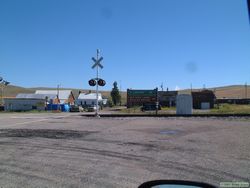 Our drive north was quite smooth and uneventful, but still long. Except for one fairly short slow-up in Phoenix due to an accident, we made excellent time, and made it the 975 miles to Pocatello, Idaho in 15 hours, where we quit for the day. The next morning we had the free continental breakfast and hit the road by around 7:30. We continued north to Monida, which is right on the border between Montana and Idaho (get it? Mon-Ida?). Monida is a sleepy little town, assuming of course it can even be considered a town. There isn't much to it. From there we left the interstate and hit the dirt, heading east to Red Rock Lakes National Wildlife Refuge.
Our drive north was quite smooth and uneventful, but still long. Except for one fairly short slow-up in Phoenix due to an accident, we made excellent time, and made it the 975 miles to Pocatello, Idaho in 15 hours, where we quit for the day. The next morning we had the free continental breakfast and hit the road by around 7:30. We continued north to Monida, which is right on the border between Montana and Idaho (get it? Mon-Ida?). Monida is a sleepy little town, assuming of course it can even be considered a town. There isn't much to it. From there we left the interstate and hit the dirt, heading east to Red Rock Lakes National Wildlife Refuge.
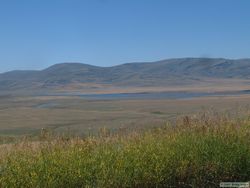 The road wound us through a fairly broad valley, and it wasn't long before we could see water below us in the flats.
The road wound us through a fairly broad valley, and it wasn't long before we could see water below us in the flats. 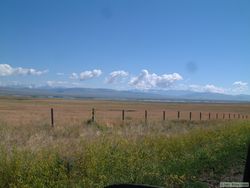 It would be some time before we actually got to the refuge, though. The road, though rough and a bit rocky, was easily traversable by passenger car. If our severely over-loaded Chevy Prizm could do it, nearly any car should. Of course, that's when the road is dry. The road looked like it might become significantly more interesting when wet and muddy.
It would be some time before we actually got to the refuge, though. The road, though rough and a bit rocky, was easily traversable by passenger car. If our severely over-loaded Chevy Prizm could do it, nearly any car should. Of course, that's when the road is dry. The road looked like it might become significantly more interesting when wet and muddy.
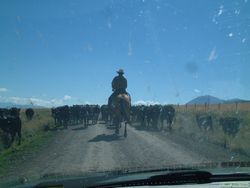 Along the way, we got to participate in a cattle drive. Yee haw! Three cowboys (well, two cowboys and a cowgirl) were driving about a hundred head of cattle down the road to the refuge.
Along the way, we got to participate in a cattle drive. Yee haw! Three cowboys (well, two cowboys and a cowgirl) were driving about a hundred head of cattle down the road to the refuge. 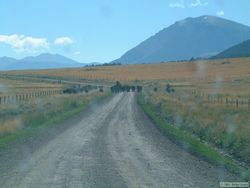 The cattle didn't want to get off the road, so one of the cowboys had to drive straight through them, telling us to stay right behind him.
The cattle didn't want to get off the road, so one of the cowboys had to drive straight through them, telling us to stay right behind him.
They were just about the only people we saw until we got to the refuge, 28 miles from the Interstate. Montana is definitely open, largely lonely country. Along the road, we saw the remnants of many ranch houses and barns, and only a few ranches that looked lived on. Derelict yet picturesque old buildings were a common sight throughout our journey through the state.
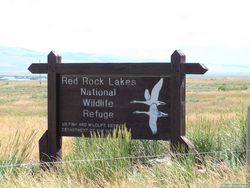
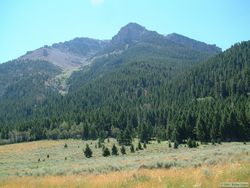 When we got to the refuge, we went to the visitors center. It is a modest place, as one might expect for a refuge that is a long way from most things.
When we got to the refuge, we went to the visitors center. It is a modest place, as one might expect for a refuge that is a long way from most things. 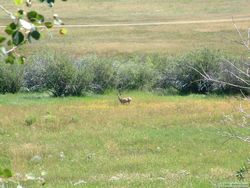 We spoke for a while with a volunteer about the refuge and the Trumpeter swans (Cygnus buccinator) that the refuge is famous for. They aren't as numerous there as I had imagined, and the woman told us that the only ones she knew of were on a little pond just off the road. The area around the pond was closed, but you could usually see them from the road. There was a pair of adult swans and 3-4 cygnets (young swan). So off we went to Shambow Pond
We spoke for a while with a volunteer about the refuge and the Trumpeter swans (Cygnus buccinator) that the refuge is famous for. They aren't as numerous there as I had imagined, and the woman told us that the only ones she knew of were on a little pond just off the road. The area around the pond was closed, but you could usually see them from the road. There was a pair of adult swans and 3-4 cygnets (young swan). So off we went to Shambow Pond
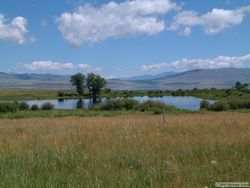
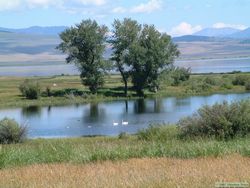 When we got there, we were happy to see that the swans were indeed swimming around the small pond, which had as it's background the main body of Upper Red Rock Lake. They were quite distant, but we got a pretty good look at them through the spotting scope.
When we got there, we were happy to see that the swans were indeed swimming around the small pond, which had as it's background the main body of Upper Red Rock Lake. They were quite distant, but we got a pretty good look at them through the spotting scope.
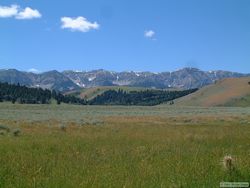 After watching the swans for a while, we continued east to see what there was to see. We continued past the refuge boundary a short distance before turning around. We then went to Lower Red Rock Lake.
After watching the swans for a while, we continued east to see what there was to see. We continued past the refuge boundary a short distance before turning around. We then went to Lower Red Rock Lake. 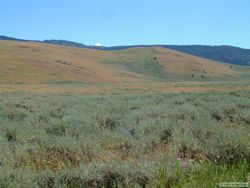 We drove out to the Lower Lake "campground" and had a quick lunch there before launching our brand new Advanced Elements inflatable kayak into the lake for an afternoon paddle. Right when we got to the campground (little more than some pit toilets on a vast grassland/marsh) we saw two more Trumpeter Swans, so once we ate lunch and got the 'yak on the water, we went looking for them. Lower Red Rock Lake was more marshy than Upper Red Rock Lake (which is why I chose to paddle the lower lake) with open pathways between large patches of marsh grass.
We drove out to the Lower Lake "campground" and had a quick lunch there before launching our brand new Advanced Elements inflatable kayak into the lake for an afternoon paddle. Right when we got to the campground (little more than some pit toilets on a vast grassland/marsh) we saw two more Trumpeter Swans, so once we ate lunch and got the 'yak on the water, we went looking for them. Lower Red Rock Lake was more marshy than Upper Red Rock Lake (which is why I chose to paddle the lower lake) with open pathways between large patches of marsh grass.
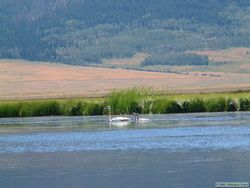 Once we were down on the water it was impossible to see up and over the marsh grasses, so I had to guess which way they went at about a half-dozen junctions in the marsh, so it took us a while before we found the swans. Quite frankly, I'm surprised that we actually succeeded. When we did find them, we discovered that these swans had two cygnets in their care. They quickly disappeared around a corner and we followed. Shan immediately pulled the camera out and I paddled to try to get within photograph range. What I soon discovered was that swans can swim faster than I can paddle without making a terrible racket, so I had to have Shan put the camera down to help paddle. Eventually, we got close enough to take some decent pictures, at which point the adults hid their cygnets in the grass and split up, trying to lure us away from their young.
Once we were down on the water it was impossible to see up and over the marsh grasses, so I had to guess which way they went at about a half-dozen junctions in the marsh, so it took us a while before we found the swans. Quite frankly, I'm surprised that we actually succeeded. When we did find them, we discovered that these swans had two cygnets in their care. They quickly disappeared around a corner and we followed. Shan immediately pulled the camera out and I paddled to try to get within photograph range. What I soon discovered was that swans can swim faster than I can paddle without making a terrible racket, so I had to have Shan put the camera down to help paddle. Eventually, we got close enough to take some decent pictures, at which point the adults hid their cygnets in the grass and split up, trying to lure us away from their young.
At that point we decided to leave them alone, but as we left, one of the adults gave us a good show by flying a short distance away. It was amazing to see the large swan take wing. I got a nice series of shots of the display. I wish the scans turned out a little better though.
And here are Shan's shots of the event:
To learn about the rest of our trip (or go back to the main trip report), click the 'Pre-Hike' link below.
 Our drive north was quite smooth and uneventful, but still long. Except for one fairly short slow-up in Phoenix due to an accident, we made excellent time, and made it the 975 miles to Pocatello, Idaho in 15 hours, where we quit for the day. The next morning we had the free continental breakfast and hit the road by around 7:30. We continued north to Monida, which is right on the border between Montana and Idaho (get it? Mon-Ida?). Monida is a sleepy little town, assuming of course it can even be considered a town. There isn't much to it. From there we left the interstate and hit the dirt, heading east to Red Rock Lakes National Wildlife Refuge.
Our drive north was quite smooth and uneventful, but still long. Except for one fairly short slow-up in Phoenix due to an accident, we made excellent time, and made it the 975 miles to Pocatello, Idaho in 15 hours, where we quit for the day. The next morning we had the free continental breakfast and hit the road by around 7:30. We continued north to Monida, which is right on the border between Montana and Idaho (get it? Mon-Ida?). Monida is a sleepy little town, assuming of course it can even be considered a town. There isn't much to it. From there we left the interstate and hit the dirt, heading east to Red Rock Lakes National Wildlife Refuge.












